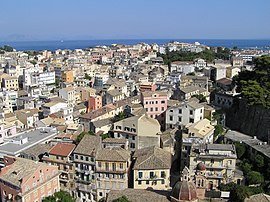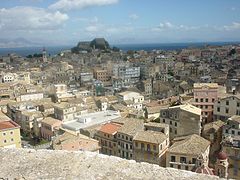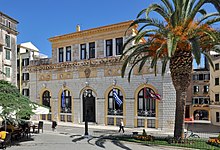Corfu (city)
Corfu
Κέρκυρα | |
|---|---|
Settlement | |
 Corfu, as seen from the New Fortress | |
 | |
| Country | Greece |
| Administrative region | Ionian Islands |
| Regional unit | Corfu |
| Municipality | Corfu |
| Area | |
| • Municipal unit | 41.905 km2 (16.180 sq mi) |
| Highest elevation | 10 m (30 ft) |
| Lowest elevation | 0 m (0 ft) |
| Population (2001)[1] | |
| • Municipal unit | 39,487 |
| • Municipal unit density | 940/km2 (2,400/sq mi) |
| Time zone | UTC+2 (EET) |
| • Summer (DST) | UTC+3 (EEST) |
| Postal code | 491 xx |
| Area code(s) | 26610 |
| Vehicle registration | ΚΥ |
| Website | www.corfu.gr |
Corfu (Template:Lang-el - Kérkyra) is a city and a former municipality on the island of Corfu, Ionian Islands, Greece. Since the 2011 local government reform, it is part of the municipality Corfu, of which it is a municipal unit.[2] It is the capital of the island and of the Corfu regional unit. The city also serves as a capital for the region of the Ionian Islands. The city (population 28,185 in 2001) is a major tourist attraction, and has played an important role since the 8th century. The city has become known as a Kastropolis (Castle City) because of its two castles.[3] In 2007, the old town of the city was inscribed on the UNESCO World Heritage List.[4][5][6] The municipal unit of Corfu city has a land area of 41.905 km2 (16.180 sq mi) and a total population of 39,487 inhabitants. Besides the city of Corfu/Kérkyra, its largest other towns are Kanáli (population 3,556), Potamós (2,365), Kontokáli (1,616), Alepoú (1,606), and Gouviá (952).
Climate
Corfu city has a Mediterranean climate. The summers are hot, dry and humid with temperatures reaching 33 °C (91 °F). The winters are mild and wet, temperatures around on or above 10 °C (50 °F).
| Climate data for Corfu | |||||||||||||
|---|---|---|---|---|---|---|---|---|---|---|---|---|---|
| Month | Jan | Feb | Mar | Apr | May | Jun | Jul | Aug | Sep | Oct | Nov | Dec | Year |
| Record high °C (°F) | 20.5 (68.9) |
22.4 (72.3) |
26.0 (78.8) |
28.0 (82.4) |
33.8 (92.8) |
35.6 (96.1) |
42.4 (108.3) |
40.0 (104.0) |
37.4 (99.3) |
31.0 (87.8) |
25.0 (77.0) |
22.0 (71.6) |
42.4 (108.3) |
| Mean daily maximum °C (°F) | 13.9 (57.0) |
14.2 (57.6) |
16.0 (60.8) |
19.0 (66.2) |
23.8 (74.8) |
28.0 (82.4) |
30.9 (87.6) |
31.3 (88.3) |
27.6 (81.7) |
23.2 (73.8) |
18.7 (65.7) |
15.3 (59.5) |
21.8 (71.2) |
| Daily mean °C (°F) | 9.7 (49.5) |
10.3 (50.5) |
12.0 (53.6) |
14.9 (58.8) |
19.6 (67.3) |
23.9 (75.0) |
26.4 (79.5) |
26.3 (79.3) |
22.7 (72.9) |
18.4 (65.1) |
14.3 (57.7) |
11.1 (52.0) |
17.5 (63.5) |
| Mean daily minimum °C (°F) | 5.1 (41.2) |
5.7 (42.3) |
6.8 (44.2) |
9.2 (48.6) |
12.9 (55.2) |
16.4 (61.5) |
18.4 (65.1) |
18.8 (65.8) |
16.5 (61.7) |
13.4 (56.1) |
9.9 (49.8) |
6.8 (44.2) |
11.7 (53.1) |
| Record low °C (°F) | −4.5 (23.9) |
−4.2 (24.4) |
−4.4 (24.1) |
0.0 (32.0) |
4.6 (40.3) |
8.7 (47.7) |
10.0 (50.0) |
11.3 (52.3) |
7.2 (45.0) |
2.8 (37.0) |
−2.2 (28.0) |
−2.0 (28.4) |
−4.5 (23.9) |
| Average rainfall mm (inches) | 136.6 (5.38) |
124.6 (4.91) |
98.1 (3.86) |
66.7 (2.63) |
37.0 (1.46) |
14.1 (0.56) |
9.2 (0.36) |
19.0 (0.75) |
81.3 (3.20) |
137.7 (5.42) |
187.4 (7.38) |
185.6 (7.31) |
1,097.3 (43.20) |
| Average rainy days | 16.1 | 14.6 | 14.5 | 12.9 | 8.0 | 4.9 | 2.3 | 3.4 | 7.0 | 11.8 | 15.7 | 17.5 | 128.7 |
| Average relative humidity (%) | 75.4 | 74.3 | 73.4 | 72.8 | 69.5 | 63.4 | 60.0 | 62.2 | 70.4 | 74.6 | 77.5 | 77.2 | 70.7 |
| Mean monthly sunshine hours | 117.7 | 116.8 | 116.0 | 206.5 | 276.8 | 324.2 | 364.5 | 332.8 | 257.1 | 188.9 | 133.5 | 110.9 | 2,545.7 |
| Source 1: Hellenic National Meteorological Service[7] | |||||||||||||
| Source 2: NOAA (extremes and sun 1961−1990)[8] | |||||||||||||
Architecture


| UNESCO World Heritage Site | |
|---|---|
 View of the old town | |
| Criteria | Cultural: iv |
| Reference | 978 |
| Inscription | 2007 (31st Session) |
| Coordinates | 39°37′N 19°55′E / 39.617°N 19.917°E |
The old fortifications of the town, formerly so extensive as to require a force of from 10,000 to 20,000 troops to man them, were in great part thrown down by the English in the 19th century. In several parts of the town may be found houses of the Venetian time, with some traces of past splendour, but they are few compared to the British Neoclassical housing of the 19th and early 20th centuries. The Palace of St. Michael and St. George, built in 1815 by Sir Thomas Maitland (1759–1824; Lord High Commissioner of the Ionian Islands) is a large structure of white Maltese stone. Near Gasturi stands the Pompeian style Achilleion, the palace built for the Empress Elizabeth of Austria, and purchased in 1907 by the German emperor, William II.
Of the thirty-seven Greek churches the most important are the cathedral, dedicated to Our Lady of the Cave; St. Spiridon's, with the tomb of the patron saint of the island; and the suburban church of St Jason and St Sosipater, reputedly the oldest in the island. The city is the seat of a Greek and a Roman Catholic archbishop; and it possesses a gymnasium, a theatre, an agricultural and industrial society, and a library and museum preserved in the buildings formerly devoted to the university, which was founded by Frederick North, 5th Earl of Guilford (1766–1827, himself the first chancellor in 1824) in 1823, but disestablished on the cessation of the English protectorate.
Based on the ICOMOS evaluation of the old town of Corfu,[5] it was inscribed on the World Heritage List. The ICOMOS experts have noted that "about 70% of the pre-20th century buildings date from the British period" and that "whole blocks were destroyed" in the Old Town by the German World War II blitzes; these were "replaced by new constructions in the 1960s and 1970s". The urban fabric was classified as being predominantly of the Neoclassical period "without special architectural features for which it could be distinguished".[5]
Layout

The town of Corfu stands on the broad part of a peninsula, whose termination in the Venetian citadel (Template:Lang-el) is cut off from it by an artificial fosse formed in a natural gully, with a salt-water ditch at the bottom, that serves also as a kind of marina known as Contra-Fossa. The old city having grown up within fortifications, where every metre of ground was precious, is a labyrinth of narrow streets paved with cobblestones, sometimes tortuous but mostly pleasant, colourful and sparkling clean. These streets are called "kantounia" (καντούνια) and the older ones sometimes follow the gentle irregularities of the ground while many of them are too narrow for vehicular traffic. There is promenade by the seashore towards the bay of Garitsa (Γαρίτσα), and also a handsome esplanade between the town and the citadel called it (Λιστόν) where upscale restaurants and European style bistros abound. The origin of the name Liston has several explanations: many former Venetian cities have a square of that name, coming from a Venetian word meaning evening promenade, but it can also refer to the closed-list aspect of an up-scale area reserved to the nobility registered in the Libro d'Oro.
The citadel was depicted on the reverse of the Greek 500 drachmas banknote of 1983-2001.[9]

Culture
The city of Corfu has a long tradition in the fine arts. The Philharmonic Society of Corfu is part of that tradition. The Museum of the Philharmonic Society of Corfu presents in detail the musical heritage of the island.
Sports
Corfu is the only place in Greece where cricket is popular. It was imported into the island during British rule. The Hellenic Cricket Federation is based in Corfu and it is the only Greek sport federation that is based outside Athens.[10] The most Greek cricket clubs are based in Corfu and they star in the Greek Championship. Notable cricket clubs of Corfu are Kerkyraikos Gymnastikos Syllogos (KGS), founded in 1893, GSK Vyron, founded in 1925 and AO Phaeax founded in 1976.
In other sports, Corfu has two teams with presence in higher divisions. The football club AOK Kerkyra, founded in 1969 originally as AO Kerkyra, that plays in A Ethniki and the Water Polo club NO Kerkyra founded in 1935, with earlier presence in A1 Ethniki Polo.
| Sport clubs based in Ampelokipoi | ||||
|---|---|---|---|---|
| Club | Founded | Sports | Achievements | |
| Kerkyraikos G.S. | 1893 | Basketball, Cricket, Track and Field | Panhellenic titles in Cricket, earlier presence in Beta Ethniki Basketball | |
| GSK Byron | 1925 | Cricket | Panhellenic titles in Cricket, | |
| NO Kerkyra | 1935 | Water Polo , Swimming | Earlier presence in A1 Ethniki Water Polo | |
| AOK Kerkyra (originally as AO Kerkyra) | 1969 | Football | Presence in A Ethniki | |
| AO Phaeax | 1976 | Basketball, Cricket | Panhellenic titles in Cricket | |
Government





Mayors
Up until 1866, Corfu had no mayors. This list starts from 1866 and on.[11]
- Nikolaos V. Manesis (1866–1870)
- Christodoulos M. Kiriakis (1870–1879)
- Georgios Theotokis (1879–1885)
- Ioannis Padovas (1885-1887)[12]
- el (1887–1895)
- el (1895–1899)
- Dimitrios Kollas (1899–1911)
- Ioannis Mavrogiannis (1914–1925)
- Spiridon Kollas (1925–1951)
- Stamatios Desyllas (1951–1955)[13]
- Maria Desylla-Kapodistria (1956–1959), first female mayor in Greece.[13]
- Panagiotis Zafiropoulos (1959–1964)
- Spyros Rath (1964–1967)
- Konstantinos Alexopoulos (1974–1975)
- Spyros Rath (1975–1978)
- Ioannis Kourkoulos (1979–1990)
- Chrisanthos Sarlis (1991–2002)
- Alexandros Mastoras (2003–2006)
- Sotirios Micallef (2007–2010)
- Ioannis Trepeklis (2011–2014)
- Kostas Nikolouzos (2014–)[14]
Consulates
Corfu is home to many foreign consulates.[15]
|
International relations
Twin towns — Sister cities
Corfu is twinned with:[17][18]
|
|
Quarters
|
|
In popular culture
Corfu plays a central role in the science-fiction novel Year Zero, by Jeff Long. The epidemic that ravages through the world's population originates at a rich archaeological artifacts collector's mansion in or around Corfu, when a 2000-year-old vial is opened, containing a lethal virus. This virus also receives the name of Corfu.
Gallery
-
Vido island near the city
-
Old depiction of Corfu, 1487
-
Old Fortress on Castel a Terra and Castel a Mare
-
Belltower of the Saint Spyridon Church, patron saint of the city
-
Panagia Mandrakina
-
Saint George Temple at the Old Fortress
-
View of Spilias Square
-
Liston
-
Achilleion façade
-
Statue of Georgios Theotokis
-
Panorama of the city
-
Carnival in Kerkyra by Charalambos Pachis
References
- This article incorporates text from a publication now in the public domain: Chisholm, Hugh, ed. (1911). Encyclopædia Britannica (11th ed.). Cambridge University Press.
{{cite encyclopedia}}: Missing or empty|title=(help)
Notes
- ^ De Facto Population of Greece Population and Housing Census of March 18th, 2001 (PDF 39 MB). National Statistical Service of Greece. 2003.
- ^ Kallikratis law Greece Ministry of Interior Template:El icon
- ^ "Home Page". Municipality of Corfu. Retrieved 2010-03-23.
- ^ BBC news on UNESCO World Heritage list
- ^ a b c UNESCO Advisory Body (ICOMOS) report on Corfu History retrieved 3 July 2007
- ^ Old Town of Corfu on UNESCO website retrieved 3 July 2007
- ^ "Mean Corfu Climatic Averages". Hellenic National Meteorological Service. Retrieved 1 March 2015.
- ^ "Kekira Climate Normals 1961–1990". National Oceanic and Atmospheric Administration. Retrieved 1 March 2015.
- ^ Bank of Greece. Drachma Banknotes & Coins: 500 drachmas. – Retrieved on 27 March 2009.
- ^ "History". cricket.gr. Retrieved 17 April 2015.
- ^ "History of City Councils from the Municipality of Corfu". Municipality of Corfu. 2005-09-20. Archived from the original on April 9, 2005. Retrieved 2007-03-30.
- ^ "Municipal council of Corfu, 5th period (1883-1887)". Retrieved 17 September 2014.
- ^ a b Municipality of Corfu from the Internet archive Quote:In the elections of 1954 Stamatios Desillas was elected Mayor for a second term and remained in office until his death, Christmas Day 1955. Soon after a bye-election took place in Corfu in which the widow of the deceased Maria Desilla - Kapodistria, was elected Mayor with 5,365 votes in a total of 10,207. Maria Desilla became Mayor of Corfu on 15 April 1956 until 9 May 1959. She was the first female Mayor in Greece.
- ^ "Mayor of Corfu". corfu.gr.
- ^ "Municipality of Corfu: Tourism: Consulates". Municipality of Corfu. www.corfu.gr. 2007-02-23. Archived from the original on April 8, 2005. Retrieved 2007-03-30.
- ^ "Misiuni ale României | ROMANIA Ministry of Foreign Affairs". Mae.ro. Retrieved 2013-03-26.
- ^ a b c d e f g h i j k l m n o "AllCorfu.Com: Corfu's Twin Cities". allcorfu.com. Retrieved 25 February 2010.
- ^ "Twinned Cities". Municipality of Corfu. www.corfu.gr. 2005-09-20. Archived from the original on April 9, 2005. Retrieved 2007-03-30.
- ^ "Bratimljenje Beograda i Krfa". B92. Retrieved 2010-02-25.
- ^ "Bethlehem welcomes Corfu, fourth sister city". The Morning Call. March 22, 2013.
External links
- Municipal website
- Link to EasyBike, the bike-sharing scheme in Corfu city, a convenient and cheap way to get around.



















